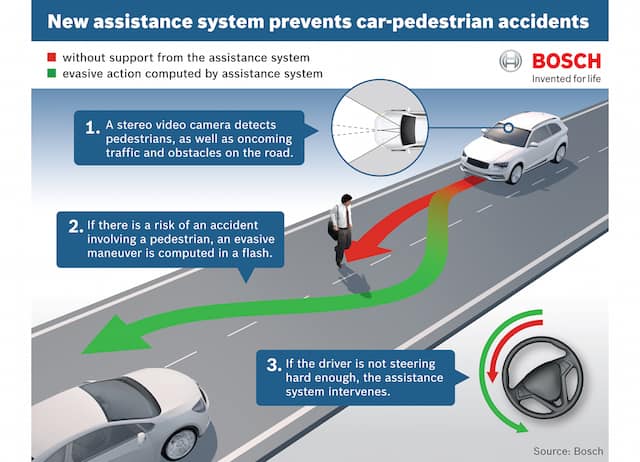The system, developed at Bosch’s new R&D centre at Renningen, will automatically intervene if it senses that the driver’s own evasive action will not be enough to prevent a collision.
It uses one of the company’s existing stereo video cameras to monitor pedestrians and oncoming traffic. An onboard computer – mounted in the boot in the case of the research vehicle – plots the likely trajectory of pedestrians within the camera’s field of view.

If a collision is thought to be likely the system will calculate the best way to take evasive action. But it doesn’t actually kick in until changes to the steering angle, vehicle speed and yaw rate indicate that the driver has initiated their own manoeuvre. From that point on, the system can brake or steer as required to prevent the collision, although the steering assistance is such that the driver can easily override it if necessary.
According to Dr Thomas Gussner from Bosch’s corporate research and advanced engineering department, provided the driver reacts at least half a second before a potential collision, the assistance system can help avoid it in 60 per cent of cases.
By far the hardest part of the project is correctly interpreting the images from the camera. Gussner said: “Pedestrians can change their state of motion very quickly. For example, they might suddenly stop or walk back or – worst of all for an evasion system – start running. “To address these challenges we developed a pedestrian model jointly with Bosch accident research, which is based on the evaluation of a large database containing real pedestrian accidents that were recorded by dash cameras. This model allows us to predict the likely future position of a pedestrian depending on the current situation and plot the evasion trajectory accordingly.”
Another crucial factor is ensuring that the area the car moves into is clear of potential danger. “[The system will only trigger] if the evasion path of the vehicle is clear and will remain clear,” Dr Gussner explained.
“This includes some very pessimistic assumptions about the trajectory of potentially dynamic objects, such as pedestrians or oncoming traffic. For example, we consider the case that a pedestrian standing on the other side of the street might unexpectedly start running into the road.”
This system is part of a suite of technologies that Bosch is working on, with the ultimate aim of developing an autonomous driving function. The company believes it will be able to offer highly automated motorway driving by 2020 and the development of image processing systems, along with long and medium range radar sensors, is a major step towards making that a reality.





Poll: Should the UK’s railways be renationalised?
The privatised rail service has always been propped up by public subsidy, so that companies could take their profits, instead of re-investing revenue...